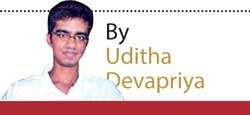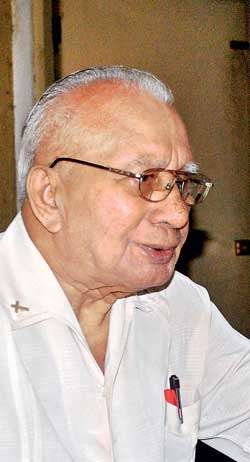Reply To:
Name - Reply Comment
Last Updated : 2024-04-23 21:35:00
 I don’t really know who or what I am – agnostic or atheist – but I do know that the secular and the divine can and do coexist, even with the involvement of the clergy, and that the clergy, especially of today, do try to bring the two together in every possible way. Nevertheless, I am not a big fan of the robe and the cassock, regardless of whatever religious sect and denomination, because of various reasons I won’t delve into here. That is why I am heartened at those who choose to go beyond their vocation while remaining in it, and that by propagating that most divine of all secular activities, the moving image, or the cinema. Ernest Poruthota, who turns 87 this August, has in that sense been an unusual priest.
I don’t really know who or what I am – agnostic or atheist – but I do know that the secular and the divine can and do coexist, even with the involvement of the clergy, and that the clergy, especially of today, do try to bring the two together in every possible way. Nevertheless, I am not a big fan of the robe and the cassock, regardless of whatever religious sect and denomination, because of various reasons I won’t delve into here. That is why I am heartened at those who choose to go beyond their vocation while remaining in it, and that by propagating that most divine of all secular activities, the moving image, or the cinema. Ernest Poruthota, who turns 87 this August, has in that sense been an unusual priest.
 Some people deserve more than a sketchy recounting of their biographies. Father Poruthota, I’ve come to realise, is one of them. So here goes, and so help me God.
Some people deserve more than a sketchy recounting of their biographies. Father Poruthota, I’ve come to realise, is one of them. So here goes, and so help me God.
He was born Raymond Ernest Alexander Poruthota in the village of Marawila in the Puttalam District. His father had taught at the time at the Government Teachers’ College in Maggona before being transferred, as part of a disciplinary procedure, to Marawila. His son studied at the Marawila Boys School, and later at St Xavier’s College, and he was not quite 12 when his parents, both staunch Catholics, decided that his vocation lay in the Church. “So they packed me off to the Borella Seminary,” he chortles silently. I asked him whether he agreed with their choice of career for him, and he readily says “Yes I did!” Not that he cut himself off from the secular world: “I was always enthralled by the arts.”
The year was 1942. He had joined the Seminary and was witnessing the horrors of the War as it unfolded in Colombo, along with the protests and the calls made for independence everywhere. Apparently he and his colleagues had been taken on compulsory walks around what is now Independence Avenue
The year was 1942. He had joined the Seminary and was witnessing the horrors of the War as it unfolded in Colombo, along with the protests and the calls made for independence everywhere. Apparently he and his colleagues had been taken on compulsory walks around what is now Independence Avenue, and what was back then Torrington Square. In 1948, having gone on one such walk, young Poruthota came across the unveiling of the National Flag at the official handing over of our independence. “I was so awed by the grandeur and the sense of majesty of the whole event, more than the cultural significance of it all. What appealed to me were the decorations, the colours, the liveliness among all those who were gathered there. When we returned to Borella, I set about replicating those decorations using crepe paper.” This was, he informed me, on account of the artist struggling to get out of him at that point: “I just couldn’t stop it.”
Those who know the man and those who have heard of him would contend that he forayed intensely into the cinema. They are correct. On the other hand, I’ve always wondered how it was that a man of the cloth, with all the restrictions that religious institutions usually place on their members, was allowed to indulge in such a plebeian and secular art form. I asked this from the man himself, and he was ready to explain. “Films were, of course, forbidden at the Seminary. By an irony of fate however, the Church did sanction us going into the theatres, provided that what we watched were Christian big budget religious epics.”
I put to him that given the preponderance of such epics in the American cinema, he and his colleagues would have imbibed DeMille, Wyler, and a horde of other such filmmakers. He agrees. “We revelled in such films as The Song of Bernadette, Quo Vadis, The Ten Commandments, and of course Ben Hur.” In later years, he would of course graduate to other directors, although his love for religious themes never evaded him. That probably explains his love for Bergman, Dreyer, and Bresson, three of the most spiritual artistes the cinema ever bred.
His contribution to our cinema in later years, one can hardly deny, was immense. He called for an indigenous cinema. He wrote. He critiqued. He had his champions and he had his critics. Some argued that a man of the Church should not engage with the secular world. In the end, however, he was vindicated. Not only was a book of his, Chitrapati Gana (An Aesthetic Evaluation of the Cinema), published in 1965 and read widely, his campaign for a national film awards ceremony overseen by the Catholic Church was affirmed when he was appointed as the first National Director of the OCIC (which later morphed into SIGNIS).
What of his other achievements? He was a founding member of the Film Critics and Journalists Association of Sri Lanka, formed in 1968. Before he became its National Director, he was also the founder of the Sri Lanka Branch of the OCIC. There probably are a great many other such laurels he can claim, but I leave the task of explicating on them to the ardent fan and meticulous biographer.
I am more interested in his views on the arts. I ask him as to whether he agrees with the thesis (forwarded by critics like Harold Bloom and, closer to home, my friend Dhanuka Bandara) that a work should be judged in terms of its inherent aesthetic merit, and not content. He disagrees. “First and foremost, a play, a film, or even a book must spiritually elevate its ‘rasikaya’. In fact that is the main criterion we have at SIGNIS.” I put to him here that even secular works of art, authored by atheists and humanists, have merit which can hardly be attributed to spirituality. Being the mild-tempered man he is, he agrees, with a caveat: “If a work is not religiously inclined, it must at least have a human element.”
The last time I checked on Father Poruthota, he was Parish Priest at the Lunawa Church in Moratuwa. This was in 2014. He’s still there. Retired in all but name, and battling on the way as best he can
From here I move on to a theme that has arguably engaged him the most over the years: censorship. Given his lifelong and austere stand on the matter, I am not surprised by his views, which even brought him into conflict with the Church. The man clearly practices what he preaches, as seen in how he went to watch films as a seminarian: “We were neither allowed nor forbidden to watch films. I went to see them unsure of whether they were allowed for a would-be priest. This was true especially in the 1960s, when we had many European directors revolutionising the cinema as we knew it then thanks to the so-called ‘New Wave.’ Morals and conventions of any sort were being defied and that became more or less the norm. Clearly, they were hardly congruent with what the Church deemed as ‘good films’. Nevertheless, I saw them. And how!”
The last time I checked on Father Poruthota, he was Parish Priest at the Lunawa Church in Moratuwa. This was in 2014. He’s still there. Retired in all but name, and battling on the way as best he can. I remember a tribute to him penned by Professor Anton Meemana in which the latter observed that while several parishioners, aware of his penchant for flouting convention, welcoming him with the graffiti “Viplawakaraya Apata Epa” (“We do not need the revolutionary”). If this is true (and I think it is), it’s an enduring testament to the man’s character that he has not let scenes and episodes like that ruffle his calm demeanour. 87 years, you must admit, is not an easy age to reconcile yourself to, and this gentle giant, beloved by followers of his faith as well as agnostics like myself, has taught us that censorship, be it in the name of the State or the Church, cannot thrive where the arts flourish, if at all because the arts, as I mentioned before, happen to be the most divine of all secular activities. “It takes us closer to God,” Father Poruthota would have said. Being an agnostic, I would nevertheless have agreed. Heartily.

Add comment
Comments will be edited (grammar, spelling and slang) and authorized at the discretion of Daily Mirror online. The website also has the right not to publish selected comments.
Reply To:
Name - Reply Comment
On March 26, a couple arriving from Thailand was arrested with 88 live animal
According to villagers from Naula-Moragolla out of 105 families 80 can afford
Is the situation in Sri Lanka so grim that locals harbour hope that they coul
A recent post on social media revealed that three purple-faced langurs near t